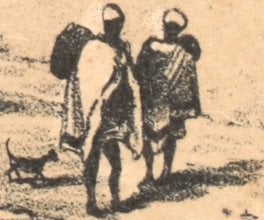Aborigines & the gold rush
Explorers and squatters had already disrupted traditional ways of life for Aboriginal people in the Victorian gold fields region. Flocks of sheep and cattle had already changed the environment and now crowds of men left significant scarring on the natural landscape.
Miners cut down trees to use for firewood, housing and the boards that reinforced tunnels. Mining turned clear streams into cloudy ones. Sometimes miners diverted whole creeks and rivers to use the water in a new area. It pitted the landscape with holes which would then serve as garbage pits. That they were occupying and damaging the traditional land of people from the Kulin nation was not a thought that entered most miners' minds.
Indigenous Australians were marvelled at for their physical skills in hunting and tracking. Europeans like Elizabeth Ramsay-Laye (writing in 1861) were amazed by the displays of Indigenous Australians near Avoca throwing boomerangs. She described the 100 yards (92 metres) flight of this 'half-moon' that returned to the thrower's feet as 'most astonishing'.
Indigenous shelter constructions became the models for the early miners and there are many stories of the assistance they gave to miners who had become lost or had run out of food and water. In many of the contemporary accounts it is clear that Indigenous Australians were participating in the economy; selling food and clothing to the miners and providing information about tracks and water sources.
They were also finding gold independently and using it to trade. Unfortunately most of these interactions are summarised briefly in the European sources and without the names of the individuals involved:
Even the Aborigines are wealthy in these times. I met a party of them at Bullock Creek well clothed, with a good supply of food, new cooking utensils, and money in their pockets. One remarked, with becoming expression of dignity, 'me no poor blackfellow now, me plenty rich blackfellow.'
- James Bonwick
Bonwick, J 1852 Notes of a gold digger and gold digger's guide, R. Connebee, Melbourne, Vic.
The importance of Indigenous guides cannot be overstated. A recent study by Dr Fred Cahir has surveyed some of the roles performed by local Indigenous people:
The very significant and varied roles Aboriginal guides fulfilled especially in the initial alluvial gold rush period when vast tracts of Victoria remained trackless or at best rudimentary is monumental - showing new goldfields, rescuing, providing food, liaising, warning, trading and naming features in the landscape, determining the most direct and easily traversable route (often along traditional pathways) and locating food, medicine and water in order to sustain their non-Indigenous companions, safely conveying gold seekers and others by fording rivers safely, preparing temporary shelters, acting as diplomats and interpreters, negotiating passage through the country of resident clans met on the line of march and locating precious waterholes for horses and other stock.
- Dr Fred Cahir
Cahir, F 2010 'Are you off to the diggings?' The La Trobe journal, State Library of Victoria Foundation, Vol. 85, Melbourne, Vic.
Corroborees were popular events in some regions and were held for payment; reported upon by the newspapers and attended by large crowds of people. Possum skin cloaks were highly sought after, selling for as much as £5, and known as the best way to keep out the cold. The Aboriginal Trackers were also the first law enforcers on the goldfields, checking licences and riding along with the Government Gold Escort protecting miners' gold from bushrangers.
As historians like Cahir point out, Indigenous Australians were not simply victims of the Victorian goldrushes. Rather they were actively engaged in a range of roles created in the turbulent period. Usually these roles were overlooked in the retelling. The work of recent historians has given us a more complete picture of the Indigenous response to the discovery of gold.











